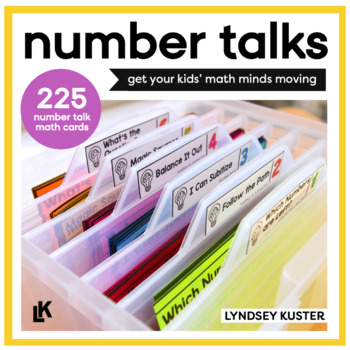Math Logic Puzzles - Number Talk Task Cards - Math Enrichment - 1st & 2nd Grade
- PDF
What educators are saying
Description
These math logic puzzles/number talks are the perfect way to get your first and second grade enrichment students’ math minds moving from the concrete to the abstract. I like to think about number talks as the bridge between the two points. Even giving students just 10 minutes each day to talk about math with their peers can help build number sense.
Included in the bundle:
- 225+ number talk cards – vary in level of difficultly; some are more difficult to solve than others
- Math Mind Mat -This can be used as a work space for students to show their thinking. Students can write down the strategies they used to solve the problem.
- Labels for organizational purposes
Why Use Number Talks?
The real truth is: students who lack a strong number sense have trouble developing the foundation needed for even simple math. Number sense develops through the exploration of numbers, visualizing numbers, and relating to numbers in different ways.
Number talks encourage students to think critically and persevere in problem solving. Each task asks students to explain to themselves the meaning of a problem and to look for entry points to its solution. The ultimate goal is to encourage students to build their own toolkit for solving problems, and these number talks do just that!
Number talks can be used in the following ways:
- whole group instruction
- number talks/morning meeting/calendar time
- small group instruction
- early finisher activity
- center/station math activity
- extension activity
- enrichment activity
Be sure you give students ample opportunities to tackle these problems without explicitly teaching them how to solve them. In other words, if you choose to work through these during whole group instruction or small group instruction time, leave plenty of time for thinking, exploration, discussion, and reflection. The key is to provide a lot of prompting and support without explicitly teaching them how to solve the problems.
Organizational Tips:
To store the materials, I purchased IRIS Greeting Card and Craft Keeper bins. I purchased them from Michael’s. You can also find them at Joann’s, Amazon, and many other stores online and in-store. If you buy them in person, be sure to bring a coupon to get an extra discount on your purchase!
All labels to organize the number talk cards are included in this bundle.
When printing the number talks, my tip is to print them on colored cardstock to match the divider labels. This is a hassle-free way to keep the materials organized!
The divider labels have the title of each activity on them, along with the standard/skill (in the bottom right corner).
*If you choose to use different storage bins than the ones I've suggested, I've included additional labels in this bundle for you!*
___________________________________
You may also like…
→ 1st Grade Math Centers Bundle (Flip Books)
→ Math Centers for the 1st Graders Bundle
→ Write and Wipe - The Math Bundle
___________________________________


